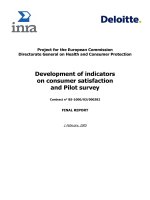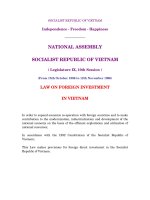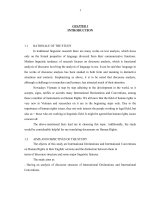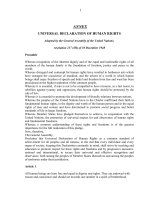MAJOR ACCIDENTS ON SHIPS
Bạn đang xem bản rút gọn của tài liệu. Xem và tải ngay bản đầy đủ của tài liệu tại đây (2.18 MB, 61 trang )
www.marineinsight.com
A Pocket Guide
Major Accidents On Ships
Preventions
&
Safety Measures
Publication date: July' 2014
Copyright 2014 Marine Insight
Author: Raunek Kantharia
Editor: Raunek Kantharia
Published by: Marine Insight
Graphic Design: Anish Wankhede / Swapna Lekshmanan
NOTICE OF RIGHTS
All rights reserved. No part of this book may be rewritten, reproduced, stored in a retrieval
system, transmitted or distributed in any form or means, without prior written permission
of the publisher.
NOTICE OF LIABILITY
The authors and editors have made every effort possible to ensure the accuracy of the
information provided in the book. Neither the authors and Marine Insight, nor editors or
distributors, will be held liable for any damages caused either directly or indirectly by the
instructions contained in this book, or the equipment, tools, or methods described herein.
2
Table of Contents
Ch.
1.
2.
3.
4.
5.
6.
7.
8.
9.
10.
Major Accidents On Ships
Title
Man Overboard
Enclosed Space Accident
Electrical Shock Accident
Explosion in Machinery
Mooring Operation Accident
Falling from Height
Lifeboat Testing Accident
Hot Work Accident
Fall from Gangway / Pilot Ladder
Fire Accident
No.
05
09
14
17
23
27
32
36
44
50
3
www.marineinsight.com
No seafarer wants to get hurt or suffer injuries while working on ships. We all know it’s a
hostile working environment a sea and no matter how many precautions we take,
accidents are bound to happen.
In the last couple of years, a series of regulations has been introduced and implemented
to ensure safety and security of seafarers working on ships. However, human error is one
such factor that has been a major contributor to fatal accidents around the world.
There are a few types of life threatening accidents which repeatedly take place on board
ships in spite of following all safety procedures, most of them because of human error.
As seafarers, it is therefore important that you are aware of these fatal accidents and
take extra precautions to get rid of all those causes from your working and living
environment.
This pocket guide is an effort to enhance personal safety of seafarers by minimizing the
effects of the most common accidents that occur on ships.
Let’s take a look at some of the major accidents of ships.
Major Accidents On Ships
4
Chapter 1: Man Overboard
Man overboard situation is
one of the most common and
dangerous situations wherein
a person falls into water while
working on board or as a
result of an accident.
Though seafarers are trained
to deal with such situations,
bad weather and heavy sea
can spoil the rescue operation.
Areas with extreme water
temperatures can also cause
hypothermia or other
dangerous health issues,
including death. Many people
have lost their lives in past in
man overboard accidents.
Major Accidents On Ships
5
www.marineinsight.com
Man overboard drills are carried out on ships to deal with such situations and to ensure
that the ship's crew are able to quickly and safely launch the rescue boat/ man overboard
recovery system to recover a person from the water. Following things should be noted
during the drill:
The recovery crew should be aware of the effects of hydrostatic squeeze and how it
will affect a casualty suffering from hypothermia.
The crew will launch and man the rescue boat. The rescue boat will be readied and
swung out to a side specified by the attending surveyor and launched into the water
in a safe and controlled manner.
Rescue boat stores must be adequate and properly checked
Rescue boat should be launched in safe manner and the crew should be suitably
dressed. Rescue boat should be in serviceable condition
Proper search and rescue procedures should be carried out for missing crew member
On completion of the drill the rescue boat must be recovered to the vessel and
readied for immediate use
Major Accidents On Ships
6
First aid requirements should be readily available.
www.marineinsight.com
The initial and early sighting of the crew gone overboard play a vital role in increasing the
percentage of saving his/her life.
Important actions to be taken when a man overboard is sighted are:
The first and foremost thing is Never to lose the sight of the fallen person and inform
others onboard by shouting “Man overboard” along with the side of the ship i.e. port
of starboard side, until someone informs the bridge and raises an alarm.
As soon as the bridge officer knows the situation, raise the ‘man overboard alarm’
and hoist signal flag “O” to inform all the ship staff and other ships in the vicinity.
Throw a lifebuoy with a smoke float, light (and SART if available) near to the fallen
person.
It is to be kept in mind not to throw more than one life buoy as it will distract the
fallen crew who is already in panic
Ship’s engine must be slowed down and ship should be turned towards the fallen
crew for recovery manoeuvre.
Major Accidents On Ships
7
www.marineinsight.com
Engine to be on stand-by all the time.
Care must be taken to manoeuvre the ship carefully as not to hit the crew in water.
Keep ready the rescue boat and muster the rescue team to take actions as soon as
possible.
Rescue the man overboard and put the person in thermal protective aid (TPA) to
avoid extra body heat loss.
Start the first aid as required.
Always try to succeed in the first attempt as even a little delay can lead to fatal
situation.
Major Accidents On Ships
8
www.marineinsight.com
Chapter 2: Enclosed Space Accidents
Enclosed space accidents are
also very common on board
ships. Such accidents occur
mainly when the ship’s crew
enters a confined/enclosed
space, which is not properly
gas-freed and has several
pockets of toxic/flammable
gases.
In spite of knowing the fact
that several lives are lost each
year, seafarers still neglect the
enclosed space entry
procedures, risking their and
other crewmembers’ lives.
Major Accidents On Ships
9
www.marineinsight.com
Procedure for Entering an Enclosed Space
The following are the points that need to be followed before entering an enclosed space.
Risk assessment to be carried out by a competent officer, as enclosed or confined
space entry is deficient in oxygen, making it a potential life hazard.
A list of jobs to be done should be made for the ease of assessment for e.g. if welding
is to be carried out or some pipe replacement is to be done. This helps in carrying out
the work quickly and easily.
Risk assessment that needs to be carried out must include what work to be done,
rescue operation to be followed etc.
Potential hazards are to be identified such as presence of toxic gases.
Opening and securing has to be done and precaution should be taken to check if the
opening of enclosed space is pressurized or not.
All fire hazard possibilities should be minimized if hot work is to be carried out.
Emptying the fuel tank or chemical tank nearby the hot work place can do this.
Major Accidents On Ships
10
www.marineinsight.com
The confined space has to be well ventilated before entering.
The space has to be checked for oxygen content and other gas content with the help of
oxygen analyzer and gas detector.
The oxygen content should read 20% by volume. Percentage less than that is not
acceptable and more time for ventilation should be given in such circumstances.
Enough lighting and illumination should be present in the enclosed space before
entering.
A proper permit to work has to be filled out and checklist to be checked so as to
prevent any accident which can endanger life.
Permit to work is to be valid only for a certain time period. If time period expires, a
new permit is to be issued and checklist is to be filled out again.
Permit to work has to be checked and permitted by the master of the ship in order to
work in confined space.
Duty officer has to be informed before entering the enclosed space.
Major Accidents On Ships
11
www.marineinsight.com
Proper signs and “Men at work” sign boards should be provided at required places so
that person should not start any equipment, machinery or operation in the confined
space, putting life of the people at risk
The checklist has to be signed by the person involved in entry and also by a competent
officer
One person must always be kept standby to communicate with the person inside the
space
The person may also carry a lifeline with him inside the enclosed space
The person should carry oxygen analyzer with him inside and it should be on all the
time to monitor the oxygen content
As soon as the level drops, the analyzer should sound the alarm and the space should
be evacuated quickly without any delay
No source of ignition has to be taken inside unless the the master or competent officer
is satisfied
Major Accidents On Ships
12
www.marineinsight.com
The number of persons entering should be constrained to the adequate number of
persons who are actually needed inside for work
Rescue equipment are to be present outside the confined space. Rescue equipment
includes breathing air apparatus and spare charge bottles
Means of hoisting an incapacitated person should be available
After finishing the work, when the person is out of the enclosed space, the after work
checklist has to be filled
The permit to work has to be closed after this
Major Accidents On Ships
13
www.marineinsight.com
Chapter 3: Electrical Shock Accidents
Just like on land, electrical shocks have also taken several lives on board ships.
Unattended electrical connections, exposed wires, and failure in taking basic precautions
while handing electrical equipment have lead to many unfortunate incidents in the past.
Steps to be taken to minimize the
risk of an electrical shock on
board:
Start with the first round of the
day; check all electrical
motors, wiring, and switches,
for abnormal sounds, variation
in temperatures, and loose
connections
Ensure that all electrical
connections are inside the
panel box so that no one can
touch them accidentally
Major Accidents On Ships
14
In accommodation area multiple socket plugs shouldn’t be used
www.marineinsight.com
Turn off the breaker before starting any work on an electrical system
Use ply card and notice board as much as possible to inform others about the ongoing
work to avoid accidental starts
Double check the electrical tools such as portable drills for any loose wires before
attempting any job.
Always wear protective clothing, rubber gloves, rubber knee pads and safety shoes to
avoid risk of shock
Use electrically insulated handle tools for working or checking electrical system
Before working, remove jewelry wrist band and other conductive items
The resistance of the human body to electric shocks is quite high only when the skin is
dry and devoid of any moisture
Note that the danger of electric shock is much greater for persons working in a hot,
humid atmosphere of the ship
Major Accidents On Ships
15
www.marineinsight.com
Working near to live equipment should be avoided if at all possible. Tools with
insulated handles should be used to minimize risks of electrical shock
In case of electrical shock accident, the treatment must be rapid if it is to be effective
The person who has met with an accident must be removed from contact with the
circuit by isolating it or using a non-conducting material to drag him away
Electric shock results in stopping of the heart and every effort must be made to get it
going again. Apply any accepted means of artificial respiration to bring about revival
In the past, fatal shocks have occurred at as low as 60V and thus all circuits must be
considered dangerous on board ships
Major Accidents On Ships
16
www.marineinsight.com
Chapter 4: Explosion in Machinery
Improperly
maintained machinery
and systems
sometimes leads to
major
blasts/explosions,
destroying the ship’s
property and killing
people working on
and around them.
Accidents such as
compressor blasts,
crankcase explosion,
boiler blast etc. have
caused serious injuries
and even death in
many cases.
Major Accidents On Ships
17
www.marineinsight.com
Though there is no particular way to stop such fatal machinery accidents, mentioned
below are some important points that should be followed as preventive measures:
1. Understand Starting / Stopping Procedures of Machinery : Every ship is different and
so are its machinery systems. Though the basic type of machinery systems remains
the same for all ships, the operating and maintenance procedures would differ
according to the manufacturer of the machine and the ship type. It is imperative for a
ship’s engineer to understand the starting and stopping procedures of his machinery
extremely well before doing everything else. This can be done by using the operating
manual of each machinery system and asking questions to fellow engine room
colleagues/seniors.
Know more about engine room machinery in
The Ultimate Guide to Operating Procedures
for Engine Room Machinery
Major Accidents On Ships
18
www.marineinsight.com
2. Read The Machinery Manual Thoroughly: As an seafarer, you must know your
machinery manual like the “back of your hand”. It’s the knowledge base on which you
will be able to build the foundation of your maintenance schedules and
troubleshooting techniques. Without knowing the construction/design of your system
and understanding how it works, you will be shooting “arrows in dark” while dealing
with an emergency situation.
3. Learn From The Machinery Records: Every engine room machinery has a history which
should be studied thoroughly by officers. This history will tell you about the all the
things that the machinery has gone through in the past including major accidents,
problems, and overhauling operations.
Know more about marine engine components in
A Guide to 2-Stroke Marine Engine
Components
Major Accidents On Ships
19
www.marineinsight.com
4. Find out Details on All Major Maintenances : Past maintenance reports helps
engineers to understand the main problems that the machinery has faced and what
are the issues that have been experienced frequently. The maintenance reports would
also include all important comments and tips that needs to be considered while
handling that particular machinery system.
5. Keep a Track of Running Hours: Depending on the running hours of the machinery, the
ship’s engineer will plan and perform the next maintenance procedure. Keeping a track
of the running hours is extremely important to prevent any kind of sudden failure or
breakdown of machinery.
6. Check If There is any Alteration Done in the Used Parts by Referring Past Records:
Ship’s machinery systems are constantly going through regular maintenance
procedures which often involves major repair works. During such procedures some of
the machinery parts are to be altered to perform repair jobs. For e.g. whenever any
major repair is done on the crank shaft pin of the marine engine (through grinding),
the dimensions of the adjoining parts like the shell bearings are also altered.
7. Know All Important Tests: All important engine room machinery and systems have
some kind of tests attached to them for their smooth operations. As a seafarer, it is
important to understand these tests and learn how are they performed and what are
the procedures involved to send the required sample to shore.
Major Accidents On Ships
20
www.marineinsight.com
Tests such as boiler water tests, generator lube oil test etc. require engineers to know
about their contents, chemicals involved and common impurities found. Learn the
purpose and procedures of these tests to ensure smooth running of your machinery.
8. Find Out Past 3 months Log Book Parameters: Log book is one such reference on
board that marine engineers have to refer every single day. Apart from this, they must
take out time to go through the log book parameters of their machinery, especially
from the past three months, in order to understand common problems or any major
changes that have taken place in their usual operations.
Know more about Overhauling Generators on Ships in
A Step By Step Guide to Overhauling
Generators on Ships
Major Accidents On Ships
21
www.marineinsight.com
Apart from the general steps mentioned above, ship personnel must also know
precautionary steps that are to be taken to prevent such machinery explosions and
accidents on board ships.
Additional Reading:
Crankcase Explosion
How to Prevent Crankcase Explosion
How to Prevent Starting Airline Explosion
Major Accidents On Ships
22
www.marineinsight.com
Chapter 5: Mooring Operation Accident
Yet another most common
reason for serious injuries
and deaths on board
ships, mooring operations
is considered an extremely
dangerous task, which
needs proper skills and
knowledge.
Several officers and
crewmembers lose their
lives every year because
of accidents related to
mooring operations.
Major Accidents On Ships
23
www.marineinsight.com
Mentioned below are ten points that must be considered while handing mooring
operation on ships:
1. Don’t Allow Any Extra Crew Member on the Deck: Ensure that no extra personnel are
present at the mooring station except those who are involved in the operation.
Anyone who is not assisting in the mooring operation must be asked to leave the
mooring station for his/her and other’s safety.
2. Consider Weather Condition: Before planning the mooring operation, consider the
weather condition by taking factors such as wind and current.
The ship’s master and responsible officer must have the details of current and future
weather data before commencing the mooring operation.
3. Have knowledge of Snap Back Zone and Rope Bight: All personnel involved with the
mooring operation should be aware of the snap back zones and rope bight.
4. Check All the Mooring Equipment: Check all the equipment (mooring winch, drums,
windlass etc.) involved in the mooring operation for any kind of problem. Proper
routine maintenance is the key to ensure smooth running of mooring equipment and
systems. Don’t forget to check the load sensors of mooring winches.
Major Accidents On Ships
24
www.marineinsight.com
5. Check the Tail of Mooring Line: If the mooring wire line is provided with tail (short
lengths of synthetic fiber rope which are placed in series with the vessel’s winchmounted wires to decrease mooring line stiffness and thus to reduce peak line loads
and fatigue due to vessel motions) ensure same size and material of tails are used for
all lines in the same service (breast, spring and head lines). Different tail size and
material would lead to uneven load in the mooring line.
6. Tend One Line at a Time: Only one line should be tended at a time during mooring
operation. If this is not done, it may increase the load in the other tended lines. If two
lines are tended together it may lead to overloading and breakage. Follow the orders
of the master or responsible ship officer properly to avoid any kind of mishap.
7. Keep a Check on the Mooring Line Load: Ensure that the allowable breaking load in
any of the mooring lines does not increase 55% of its Maximum Breaking Load (MBL).
This is to prevent the line from breaking.
8. Keep a Continuous Check: Load on the mooring lines must be checked continuously
even after the mooring operation is over. If there is any change in the ship’s ballast
condition, the lines must be slacked or tightened accordingly. The condition of the
rope material should also be checked to foresee unfortunate accidents.
Major Accidents On Ships
25









